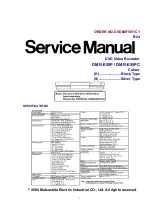
Communications Diagnostics Technical data
Commander S100 User Guide
31
Figure 4-10 Connecting the motor cable to a terminal block in the enclosure
Using a motor isolator / disconnect-switch
The motor cable shields should be connected by a very short conductor having a low inductance. The use of a flat metal coupling-bar is
recommended; conventional wire is not suitable. The shields should be bonded directly to the coupling-bar using uninsulated metal cable-clamps.
Keep the length of the exposed power conductors to a minimum and ensure that all sensitive equipment and circuits are at least 300 mm (12 in) away.
The coupling-bar may be grounded to a known low-impedance ground nearby, for example a large metallic structure which is connected closely to the
drive ground.
Figure 4-11 Connecting the motor cable to an isolator / disconnect switch
Providing surge immunity for control circuits
In applications where the control circuits may be exposed to high-energy voltage surges, some special measures may be required to prevent
malfunction or damage. Surges may be caused by lightning or severe power faults in association with grounding arrangements which permit high
transient voltages between nominally grounded points. This is a particular risk where the circuits extend outside the protection of a building.
As a general rule, if the circuits are to pass outside the building where the drive is located, or if cable runs within a building exceed 30 m, some
additional precautions are advisable. One of the following techniques should be used:
1. Shielded cable with additional power ground bonding. The cable shield may be connected to ground at both ends, but in addition the ground
conductors at both ends of the cable must be bonded together by a power ground cable (equipotential bonding cable) with cross-sectional area of
at least 10 mm
2
, or 10 times the area of the signal cable shield, or to suit the electrical safety requirements of the plant. This ensures that fault or
surge current passes mainly through the ground cable and not in the signal cable shield. If the building or plant has a well-designed common
bonded network this precaution is not necessary.
2. Additional over-voltage suppression - for the analog and digital inputs and outputs, a zener diode network or a commercially available surge
suppressor may be connected in parallel with the input circuit as shown in Figure 4-12. If a digital port experiences a severe surge its protective
alarm may operate A.7 (I/O Overload).
Figure 4-12 Surge suppression for digital and unipolar inputs and outputs
From the Drive
To the motor
Back-plate
Enclosure
Isolator
Coupling bar
From the
Drive
To the
motor
(If required)
Signal from plant
Signal to drive
0V
0V
30V zener diode
e.g. 2 x BZW50-15
Содержание COMMANDER S100
Страница 118: ...0478 0650 02...
















































